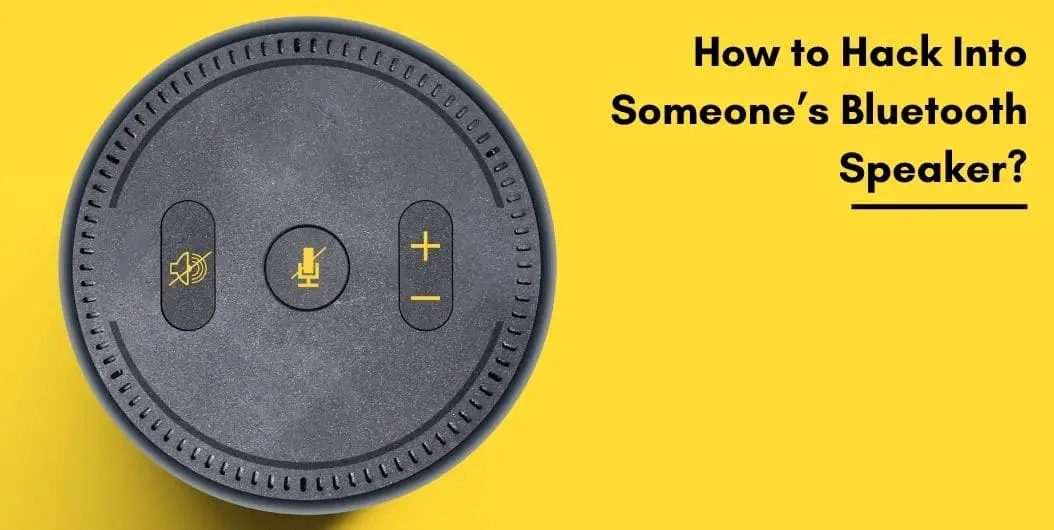Hackers can hack into a Bluetooth device using a 2.4 GHz jammer. Another common type of attack is the KNOB attack.
KNOB is a cyber threat that can affect any standard-compliant Bluetooth device due to flaws in the Bluetooth specification.
It takes advantage of a weakness in the extended version of classical Bluetooth to force Bluetooth connections to use an 8-bit encryption key.
This attack targets the firmware of a device’s Bluetooth chip, allowing hackers to perform a Man-in-the-Middle (MITM) attack.
Hacking or hijacking a Bluetooth speaker without the owner’s consent is illegal and unethical.
In This Article:
5 Common Bluetooth Vulnerabilities
Bluetooth devices are vulnerable to a range of attacks including Bluejacking, Bluesnarfing, Blueborne, Bluetooth Impersonation Attacks (BIAS), and BlueBugging.
1. Bluejacking
Bluejacking is one of the most common Bluetooth vulnerabilities, which involves sending unsolicited messages to nearby Bluetooth-enabled devices. This technique can be used by cybercriminals to spam users with misleading information, advertisements or even phishing links.
To illustrate how a typical Bluejacking attack occurs, imagine you’re sitting in a crowded coffee shop with your smartphone’s Bluetooth enabled. Suddenly, you receive an unexpected message on your device from an unknown sender.
The attacker has cleverly leveraged the proximity and open communication channel provided by your active Bluetooth connection to send you unwanted content without consent.
2. Bluesnarfing
Bluesnarfing is a Bluetooth hacking technique that allows unauthorized access to a victim’s device, without the user’s knowledge or consent. This type of attack exploits vulnerabilities in the Bluetooth protocol and can result in the extraction of sensitive information from the target device, such as contacts, messages, emails, and other files.
A real-world example of Bluesnarfing occurred in 2017 when an attacker used this technique to steal personal data from millions of fitness trackers manufactured by Jawbone.
The attacker exploited a vulnerability in these devices’ Bluetooth drivers and retrieved sensitive data such as names, email addresses, dates of birth, weight measurements, and GPS locations.
Users who were affected were not aware their data had been compromised until months later when Jawbone confirmed the breach.
3. Blueborne
Blueborne is a Bluetooth vulnerability that enables hackers to take control of devices without any interaction from the user. This means that simply having your Bluetooth turned on can put you at risk of an attack.
Blueborne allows attackers to remotely execute and spread malware across multiple devices with ease, compromising entire networks in just seconds. In 2017, this vulnerability was discovered, affecting billions of devices worldwide ranging from computers, smartphones, and smartwatches to even medical equipment like pacemakers.
One example of how Blueborne has been exploited is by using it as a gateway for ransomware attacks where data is encrypted until payment demands are met.
4. Bluetooth Impersonation Attacks (BIAS)
One of the common Bluetooth vulnerabilities is Bluetooth Impersonation Attacks (BIAS). This type of attack allows attackers to impersonate a trusted device and exploit its access capabilities.
BIAS can be executed through different techniques, including spoofing MAC addresses or Man-in-the-Middle attacks.
A recent study revealed that many Bluetooth devices are vulnerable to this type of attack due to insecure implementations of Bluetooth authentication protocols. To prevent BIAS, experts recommend disabling unnecessary features like “always discoverable” mode and implementing secure authentication methods like Secure Simple Pairing (SSP) with strong passwords.
5. BlueBugging
BlueBugging is a Bluetooth hacking technique that allows attackers to take full control of a victim’s device without their knowledge or consent. Attackers can use this technique by exploiting vulnerabilities in the Bluetooth software to bypass security measures and gain access to the device.
Once inside, they could access sensitive data, install malware or spyware, and even make calls or send messages on behalf of the victim.
In 2023, protecting oneself from BlueBugging involves staying vigilant with cybersecurity practices like keeping devices updated and turning off Bluetooth when not in use.
Additionally, avoiding pairing with unknown devices is crucial since this provides an opportunity for hackers to gain unauthorized access.
Real-World Examples Of Bluetooth Hacks
The article provides real-world examples of Bluetooth hacks, including car hacking, fitness tracker hacking, and smart home hacking.
1. Car Hacking
Hackers have been targeting cars via Bluetooth for years, and the risks continue to increase as vehicles become more connected. Hackers can exploit Bluetooth vulnerabilities to gain access to key functions of a car, such as steering, braking, and acceleration.
In 2015, researchers hacked into a Jeep Cherokee by exploiting an unpatched vulnerability in its infotainment system using Bluetooth. This allowed them to control various functions of the vehicle from afar.
As more features are added to cars with smart capabilities like remote unlocking and engine starting through smartphone apps, there is a greater risk of hackers exploiting these systems via Bluetooth connections.
2. Fitness Tracker Hacking
Fitness trackers have become increasingly popular over the years, but they are not immune to Bluetooth hacking. Once a hacker has access to a fitness tracker, they can gain access to sensitive data, including personal information and health data.
In 2018, researchers discovered that some fitness trackers were vulnerable to remote attacks due to their lack of robust security features.
To prevent fitness tracker hacking, it is essential always to keep your device updated with the latest firmware updates from the manufacturer. Be cautious about connecting your device with unknown or untrusted devices through Bluetooth and avoid sharing sensitive information over a public network.
3. Smart Home Hacking
Smart home devices are becoming increasingly popular, with millions of households having at least one connected device. However, the convenience of these devices also poses an increased risk of Bluetooth hacking.
A hacker who successfully infiltrates a smart home network could gain access to personal information such as credit card details, email addresses, and even footage from security cameras.
In 2023 alone, there were over 50 reported cases of smart homes being hacked through Bluetooth vulnerabilities. One example is the BlueBorne exploit that was discovered in 2017, which allowed hackers to take control of numerous IoT (Internet of Things) devices without any interaction from users or passwords required.
Prevention Techniques
Prevent Bluetooth hacking by keeping devices and firmware updated, using strong passwords and PINs, avoiding pairing with unknown or untrusted devices, turning off Bluetooth when not in use, and limiting Bluetooth visibility.
1. Keep Devices And Firmware Updated
Updating devices and firmware regularly is one of the most effective ways to protect Bluetooth devices from vulnerabilities. Manufacturers often release updates that fix security flaws, so it’s important to keep your devices up-to-date with the latest patches.
For example, in 2017, researchers discovered a critical vulnerability in Bluetooth-enabled chips manufactured by Broadcom and used in millions of smart cars worldwide. The flaw allowed hackers remote access to vehicle systems, including brakes and steering controls.
Keeping firmware and devices updated also ensures compatibility with new security features as they become available.
2. Use Strong Passwords And PINs
When it comes to preventing Bluetooth attacks, one of the simplest yet most effective ways is by using strong passwords and PINs. This may seem like a no-brainer, but many people still use easily guessable passwords such as “1234” or “password”.
It’s important to note that this advice applies not only to Bluetooth devices but also to all digital accounts and devices requiring a password. Using the same password across multiple accounts can also lead to security breaches if one account is compromised.
To simplify managing multiple passwords, consider using a reliable password manager app.
3. Avoid Pairing With Unknown Or Untrusted Devices
To avoid Bluetooth attacks, it is crucial to limit pairing with unknown or untrusted devices. Many hackers use social engineering techniques to gain access to sensitive information by impersonating a trusted device.
Additionally, some hackers will try to pair with your device through malicious software. These attacks will give them full access to your device and all its data. To avoid this scenario, only pair your devices with trusted sources that you know won’t be compromised.
4. Turn Off Bluetooth When Not In Use
One way to protect your Bluetooth device from hacking is by turning off the Bluetooth feature when it’s not in use. Cybersecurity experts recommend this because hackers can exploit vulnerabilities even when the device is idle, making it an easy target for attacks.
It’s important to note that even if you’re not actively using Bluetooth, it may still be active on your device unless you turn it off manually. For example, if you recently paired with another device or left Bluetooth settings open in the background, someone could potentially gain access without your knowledge.
5. Limit Bluetooth Visibility
Limiting Bluetooth visibility is an important step in securing your devices from potential attacks. When you set your device to visible, it allows other Bluetooth-enabled devices in the vicinity to detect and potentially connect with it.
To limit Bluetooth visibility, go into your device’s settings and turn off the “discoverable” or “visible” mode when not needed. This will prevent other unknown devices from detecting and pairing with yours.
By following these simple steps, you can significantly reduce the risks posed by Bluetooth exploits and ensure that your personal data remains safe from prying eyes.
Conclusion
In conclusion, Bluetooth technology has become an integral part of our daily lives, but it also presents serious security risks. The article has discussed 5 common Bluetooth vulnerabilities and provided tips for prevention.
It is essential to continuously update devices and software, use strong passwords, avoid pairing with unknown or untrusted devices, limit visibility, and turn off Bluetooth when not in use.
Additionally, we explored some hacking techniques and tools that attackers may use to infiltrate your device. In summary, following the preventive measures outlined in this article can help protect users from potential cyberattacks on their Bluetooth-enabled devices.




